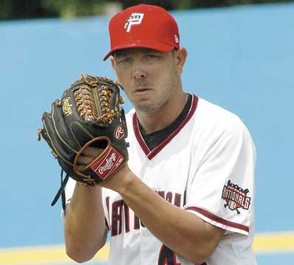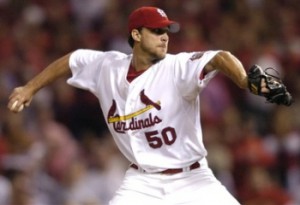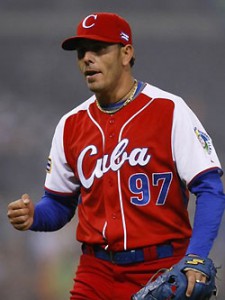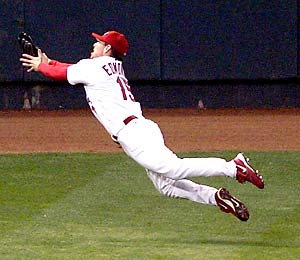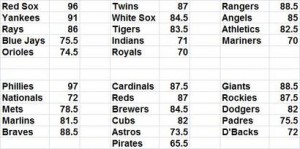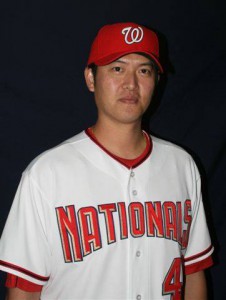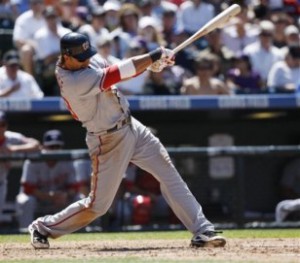
Morse did nothing but mash in 2010. Why are the Nats trying so hard to NOT use him in 2011? Photo hardballtalk.nbcsports.com
(Ironically, as I was penning/researching this posting all three leading Nats beat writers wrote similar articles. Hmm. Perhaps we’re all onto something. Here’s links to Zuckerman, Goessling and Kilgore‘s similar articles. Something must have happened in camp today…)
(Coincidentally, i’m also assuming that Rick Ankiel is a backup/fall back plan and nothing more. He’s had exactly ONE impressive hitting season and was worse than Nyjer Morgan last year splitting time between the Royals, the Braves and the DL. But it is concievable that Ankiel is “competing” for the LF job as well).
Mike Morse turned out to be one of the bright storylines for the team at the plate last year, posting a very respectable 2010 slash line of .289/.352/.519 and hitting 15 homers in just 293 at bats for a season OPS+ of 133 (3rd on the team behind Dunn and Zimmerman, just ahead of Willingham). He’s a former infielder who moves around well despite being a big guy and can play four positions relatively easily (both corner infield and both corner outfield positions).
Roger Bernadina meanwhile posted this 2010 slash line: .246/.307/.384 in 461 plate appearances. He had 11 homers and provided very good outfield defense with capabilities at all three positions.
So, given that the Nats traded away two of their best four hitters last year and clearly seem set to take a small step backwards in offensive production, why exactly is the presumed starter in left field not automatically going to be Morse?
The arguments i’ve heard are variations of three themes: lefty-righty splits at the plate, defense and balance of our lefty-righty hitters on the bench. Lets discuss each item.
1. Lefty-Righty Splits: the knock on Morse is that he cannot hit right handed pitchers. He mashes lefties but struggles against righties. Is this true? According to his 2010 splits, he clearly hits lefties better (he hit .295 versus .287 against right handers) but more significantly his slugging percentage split is significantly different (.466 versus .625 against lefties). So clearly he doesn’t hit for as much power against right handers.
The thing is, his performance as a righty versus other righties is still pretty good as compared to the league. His “sOPS+” values (sOPS+ being his Split league adjusted OPS value) was 126, meaning that he’s about 26% better than the league average for righty-righty matchups.
So, lets quickly look at Bernadina’s splits. Turns out, Bernadina actually hits lefties BETTER than righties, but his best slugging figure (.429 against lefties) is worse than Morse’s weakest slugging figure.
Conclusion: Morse may be slightly weaker against righties, but he’s better against either arm than Bernadina. He is closer to a #5 hitter in terms of power while Bernadina is a #2/#7 hitter.
2. Defense: Bernadina is clearly a better outfielder, and has a fantastic career UZR/150 rating in left. He posted a 13.3 for 2010 and has a career 11.8. Meanwhile Morse isn’t exactly Reggie Jackson patrolling left field but he’s not bad either. In very limited LF career stats he has a 15.2 uzr/150 rating in left. He’s significantly worse in Right … but then again that’s why we bought 7 years of Jayson Werth.
Meanwhile, Morse is also a very good first baseman and has logged time at SS and 3B. Bernadina is purely an outfielder but can play center in a pinch.
But here’s the thing; you don’t NEED a star quality defender in left field! Not at the expense of greatly needed offense anyway. That’s why Josh Willingham still has a job and that’s why Manny Ramirez was able to play in Boston (and in the NL) for so long.
Conclusion: Bernadina’s better in left, but both bring defensive flexibilty to the table.
3. Lefty-Right balance in the lineup. Morse is a righty, Bernadina a lefty. Lets look at the probable 25-man roster out-field players.
- Lefty only: Morgan, Bernadina, LaRoche, Ankiel
- Righty only: Pudge, Ramos/Flores, Desmond, Zimmerman, Werth, Hairston, Gonzalez
- Switch Hitters: Espinosa
But, of the presumed starters only Morgan and LaRoche are lefties. Espinosa switch-hits but he’s probably stuck in the 8-hole until he improves on last year’s tailoff at the plate. So, if we start Morse we’re looking at a lineup that probably goes L-R-R-L-R-R-R-S-Pitcher. Three straight right-handed hitters after LaRoche. If we replace Morse with Bernadina the lineup probably goes L-R-R-L-R-L-R-S-Pitcher, a much better balance.
Of course, we also have one Matt Stairs in camp and people are talking about him making the team as a designated pinch hitter. I have an awful hard time believing this, but if it happens (at the probable expense of Albert Gonzalez), then having Morse on the bench as a right-handed hitting counterpart to Stairs makes a bit of sense. Certainly having Bernadina, Ankiel AND Stairs on the bench makes no sense. But, since Stairs brings no defensive value to the team we’d be incredibly thin at infield backup positions without Morse in the fold.
Conclusion: unclear until we see how Stairs looks in spring training.
In conclusion, there are arguments on both sides for/against either Morse or Bernadina in left. Perhaps we’ll be surprised by Morse in left and Bernadina in center with Ankiel an able backup (certainly a possibility if Morgan does not improve on last year’s performance). But I find it hard to believe we’re going to sit Morse over Bernadina or Ankiel at the beginning of the season.
